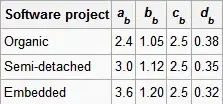The object of the exercise with COCOMO, as with any other software estimating methodology, is to answer two questions: How much will it cost and how long will it take?
What the COCOMO man-months of effort and months of duration results mean is that, when the project is over, it is estimated that you will have paid out the equivalent of that many man-months in salary, and so many months will have gone by on the calendar.
It does NOT mean that one man can do it in that many months, and it does NOT mean that that many men can do it in one month.
COCOMO estimates are based on deliverable source lines of code estimates, and yield results in man-months, because both deliverable source lines of code and expended man-months are easy to measure after-the-fact. One of them comes directly from the delivered code, and the other comes directly from the payroll data for the project. The magic numbers in COCOMO were developed by doing postmortem measurements on timecard data and line count for a large number of projects.
This allows you to calibrate the estimator to your particular organization, and improve the overall quality of your particular organization's estimates. Boehm et al strongly recommend every organization do this. The numbers they give are good starting points for an individual organization, but they are not engraved in stone tablets and they are not the Final Answer.
Basic COCOMO gives you BOTH the nominal total effort, in man-months, AND the nominal project duration, in months. To get the nominal number of people required over that duration, you divide effort by duration.
That's nominal. Basic COCOMO DOES NOT ADDRESS off-nominal schedules, either compressed or stretched out. To account for the effect of management monkey-wrenching the schedule, you must use Intermediate COCOMO or Detailed COCOMO.
To answer your second question: It is not possible to assign units to the individual magic numbers of Basic COCOMO, because the system is formally underspecified. You have no way to decide which units go with which magic number, and which units get cancelled in the dimensional (factor label) analysis.
